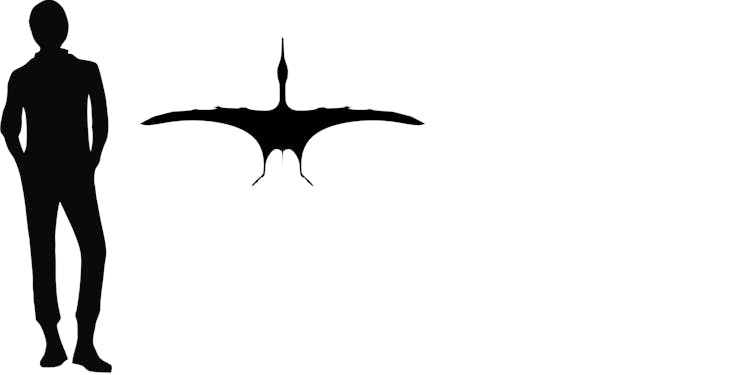


In 2009 paleontologists Eberhard Frey, Christian A. Meyer and Helmut Tischlinger named and described Aurorazhdarcho primordius, a new pterosaur from Germany’s famous Upper Jurassic Solnhofen Limestone. The specimen consists of most of the skeleton, but was missing the head and neck. In 2012, pterosaur paleontologist Chris Bennett pointed out that a previously described species known only from juvenile specimens, “Pterodactylus” micronyx, had the same peculiar limb proportions as Aurorazhdarcho. He synonymized the species, but kept the genus name Aurorazhdarcho, with the new combination Aurorazhdarcho micronyx. The genus name combines the Latin word aurora, meaning dawn, and the genus name Azhdarcho, thought by Frey, Meyer, and Tischlinger to be a close relative, while the species name primordius is Latin for earliest. The species name, micronyx, is formed from the Ancient Greek words for “small claw.”
The skeleton described by Frey, Meyer, and Tischlinger is largely complete and articulated, but missing the head and neck. Amazingly, when viewed under UV light, a distinct outline of the head and neck is visible on the limestone slab indicating that it was lost to scavengers or decomposition after the body came to rest on the seabed. The skull appears to have been about 15 cm (6 inches) long with a tapering rostrum. On the upper surface of the snout, there was a semicircular crest from near the tips of the jaw to the region before the eyes. Additionally, there is an impression of a throat pouch. The skulls of the juvenile specimens are shorter and triangular in profile, but show an elongate rostrum in larger juveniles. The teeth are long, with those near the top of the snout directed forward, and those farther back, directed vertically. The teeth of the upper and lower jaws interlocked to form a sieve or basket when the mouth was closed.
The larger specimen includes the vertebrae from the torso, sternum, both wings, pelvis, and both legs. Based on the degree of skeletal fusion, it appears to be nearly fully grown and has a wingspan of about 90 cm (3 feet). Proportions between different elements of the limbs distinguish Aurorazhdarcho from other Solnhofen pterosaurs.
When originally described, Frey, Meyer, and Tischlinger considered Aurorazhdarcho to be the earliest member of the azhdarchoid lineage based on similarities in the shoulder and limb proportions. They named a new family, Protazhdarchidae, to house Aurorazhdarcho, even though there is no genus “Protazhdarcho” to derive that name from. Bennett concluded that Aurorazhdarcho was actually a ctenochasmatid due to the long, interlocking teeth, as well as the anatomy of the feet. Ctenochasmatids are members of the earliest short-tailed pterosaur lineage, the Archaopterodactyloids, known from Upper Jurassic and Lower Cretaceous rocks from around the world.
Aurorazhdarcho was found in limestone formed in a shallow, warm-water environment with several small, low-lying islands. It would have been quite similar to modern Florida or the Bahamas. Aurorazhdarcho, like all ctenochasmatids, was a suspension feeder, using its long, interlocking teeth to trap small prey captured from the mud or water.
